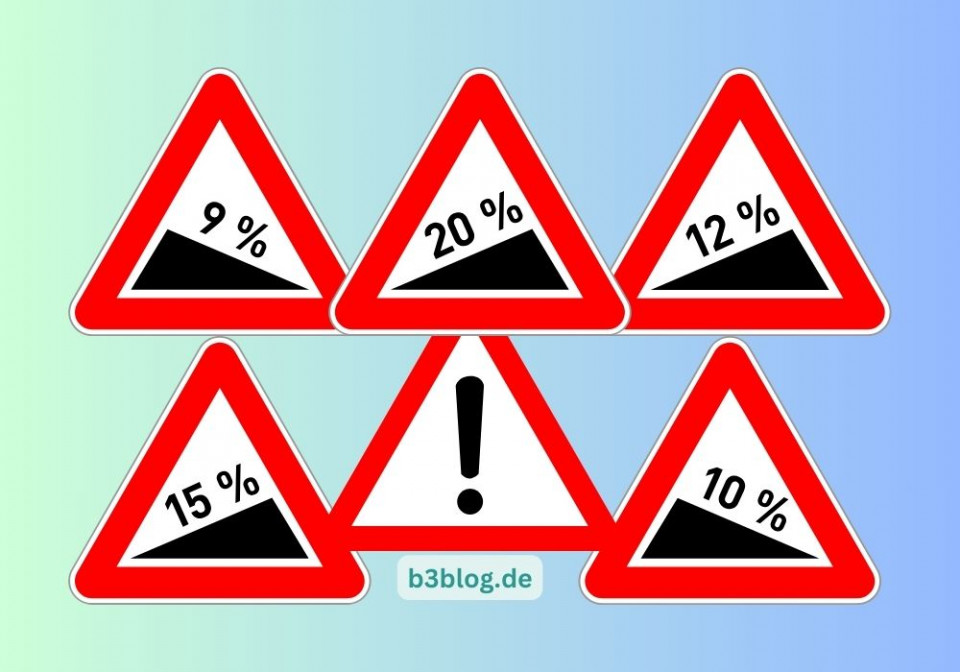analogue
... in the technical sense means continuous, stepless. An analog wristwatch, for example, has a dial with hour and minute hands that advance very gradually. The display of a digital wristwatch, on the other hand, jumps forward from minute to minute. Yes, there are also analog and digital watches with seconds display. But you understand the principle, don't you?
definition of terms
The Greek word análogos, the origin for the word analog,
actually means "according to reason". Any questions?
Computer
Without them, we wouldn't have to waste any thought on digitization. Computers are actually a type of computing device that can process ever-increasing amounts of data in ever-shorter periods of time. The precursor of computers is the mechanical calculating machine "Analytical Engine", whose concept was conceived and developed by Charles Babbage and Ada Lovelace in the first half of the 19th century.
digital
... is derived from the English word digital. The noun for it is digit, which is actually nothing more than the finger used for counting. This is also the meaning of the even older Latin word digitus: finger, toe. You know how children are taught to count: you stretch out finger after finger and say the number word. So it's very simple.
EDP
Data processing was already Ada Lovelace's concern. Electronically, the processing of data works much faster than mechanically, which is why today we almost always mean electronic data processing, or EDP for short. It encompasses several areas, from the acquisition of data and its processing to the output on a display or a storage medium, and can be found everywhere today: in the smartphone or tablet as well as in the coffee machine or the vacuum cleaner robot, but also in the car or the e-bike - to name just a few devices from our everyday lives.
FAQ
... are actually needed everywhere in life - or rather the answers to them. As you know, FAQ stands for "Frequently Asked Questions" and these are frequently asked questions. But they only became really popular with the Internet.
Googol
Googol really exists: In English, the word stands for the number 10 to the power of 100. Written out as a number, it's a 1 with a hundred zeros - it looks pretty digital. A certain search engine does not deny the connection of Googol with its own name. And graphs are known to the digital world in great quantity, though mainly in the older spelling graphs. They are used to represent relations, often in the form of lines and nodes. You don't have to be a mathematician to create graphs. Widely used, for example, is the schematic representation of family trees with name boxes and connecting lines.
HR
... could stand for High Resolution, i.e. the high resolution of images or graphics. Instead, HR today means "human resources". The German equivalent human capital sounds rather inhuman, and human resources is not the nicest German word either. Let's put it this way: There are people in the digital world, too. No matter how mathematical and technical it may be: In the end, there is always a human being behind it, in front of it, beside it, in it. And that's how we at Balcik Tech understand digital technology and the latest data solutions: by people - for people.
IT
Information Technology (IT for short) as a generic term is more than data processing: It is about all kinds of technology with which information is systematically digitally recorded, transmitted, processed and stored. There's also information technology: the distinction between the two terms is often blurred. You could say that technology is more about the science of technology. Sounds fuzzy and thus not very digital. Because it is, we remember, always about a circuit with a precisely defined number of possibilities.
JavaScript
Java is considered to be a comparatively simple object-oriented programming language. But it is not so easy that you can start coding without any previous knowledge. And Java must not be confused with JavaScript. The similarity of names has more historical reasons (a cooperation of the developer companies) than content-related or technical ones. JavaScript is known to many because the scripting language is embedded in HTML pages and thus enables interactive web applications. Even as a Norbert normal surfer and non-coder, one therefore sometimes encounters the message: JavaScript must be activated.
(KI)AI
That's as easy as jumping. AI stands for artificial intelligence, a typically German term. English speakers know AI as short form for "Artificial Intelligence" or also in good technical German: artifizielle Intelligenz. Once again, we have a term that you come across at every turn, but at the same time is
but at the same time it is not easy to define. It starts with the question of what intelligence is in the first place. My very dubious interpretation is that it is automated machine processes that pretend to model human behavior. Let's leave the theory and turn to the practice of AI: It can be used for robots, for the Internet of Things in the smart home, for speech recognition and voice control - I'll just say Alexa -, for self-driving cars.
But that's really just a tiny slice of the possibilities. Often we don't even notice anymore where AI is at work everywhere: in search engines, in image recognition, in automatic translations, and so on and so forth.
Low Code
Today, computer programs are so complex that they can't just be pulled out of a nerd's sleeve. Perhaps one or the other still remembers the programming language BASIC, with which many made their first steps into the world of the then new personal computers in the 1990s. Today's programs are far removed from this in terms of scope and possibilities. But because not every single programming cog has to be reinvented all the time, at some point people started using WYSIWYG editors, where WYSIWYG stands for "What you see is what you get". This made it possible for non-programmers to create websites, for example. Low Code is a more current variant: Building on a fixed source code, additional features can be inserted with less programming effort.
Mobile first
In the early days of the WWW, there was a little addendum on some websites that read something like this: Best viewed with browser so-and-so. Sometimes you feel like you're back in those days. But that would be comparing apples and oranges, because today the conditions are completely different. Websites not only have to look good in different browsers, but also on output devices of different sizes, from smartphones to tablets to laptops and desktop PCs. This works if they are responsive, i.e. adapt to different display sizes. The mobile-first principle states that the majority of users today view websites on mobile devices, and websites should therefore be built accordingly.
Nill
*At the beginning of digitization was the zero (see above). Not the mathematical zero is meant here. Digital zero in the sense of computer science is about zero values. This can mean that a data field was not occupied, i.e. no value was defined. So it is about the absence of a value, but at the same time the zero value represents a value. Sounds complicated? For normal mortals yes, for nerds no. Two value systems collide.
Open Source
This is the name given to software whose source code is public and can be modified and used by others, usually free of charge. Cool thing!
Password
Passwords are not a digital specialty. They have been known for a couple of centuries, the secrets were mainly used by the military. It is also logical, somehow it should be recognizable whether it is about friend or foe. In the digital world, passwords are used for personal protection; in conjunction with a user name, they help with identification. Sometimes the PIN is added, the personal identification number, which is supposed to make the recognition process even more secure.
Source text
Programs or software must be readable by machines. So that humans can also do something with it, there is the source code, which documents the program. As you know, you can display the source code of a web page by right-clicking in the browser.
Digital Revolution
How made for our digitalization blog abc. What is it? Something similar to industrialization in the 19th century, at least in its effects. Just as technical progress led to changes in all areas of life, the same is true of the digital revolution. Since the turn of the millennium, digital networking has determined our lives in one form or another; smartphones and the Internet have become indispensable. But digitization and globalization go much further - including the economy, culture and politics.
Smart Home
or smart living - do you now need a college degree to live anywhere? What is meant is the digital networking of devices and technology in the house or apartment, which is supposed to make life easier. There will be a lot more happening in the next few years.
Technique
... is, according to Duden <https://www.duden.de/rechtschreibung/Technik>, the "totality of measures, facilities and procedures that serve to make the findings of the natural sciences practically usable for humans". In other words, there's a pretty big intersection between digitization, people, and technology.
Unicode
Latin, Greek, Chinese, Korean, Arabic script - which one will it be? It took a while to develop a universal character set that could map all characters. No, not quite right, because the project is not finished, it is /work in progress/, understandable in view of the many languages and writing systems. Unicord is an international standard that is gradually defining a digital code for every known character.
VoIP
Internet telephony is usually meant by this (VoIP = Voice over IP). While ISDN was already an international standard for a digital telecommunications network, IP telephony points to the next stage of development in communications, which is currently hardly conceivable without the data networks of the Internet.
WWW
Web, website, Windows - not the resolution for WWW, but equally terms that are inextricably linked to the Internet like the World Wide W*eb, which is precisely not "the Internet" but a section of it. However, such subtleties should not prevent us from surfing the Internet using a (web) browser of our choice.
X
In mathematics, the X is a variable, an unknown quantity. In our overview, the letter may stand for all the development steps that will further advance digitization.
Yield optimization
Yield is the English word for income. That, too, is digitization: the desire to achieve the greatest possible success. It should be clear that, in the face of environmental disasters and climate change, this success must look different than it did years ago. Let's rethink together and move forward for a more humane world.
Zuse
Construction engineer Konrad Zuse (1910-1995) built the world's first working computer in 1941. How it came about and what became of his invention, you can read in the Wikipedia article <https://en.wikipedia.org/wiki/Konrad_Zuse>.
That brings us to the end of this absolutely incomplete and subjective digital alphabet. Let's agree that digitization really does affect all areas of life. We are in the middle of an exciting transformation process.


